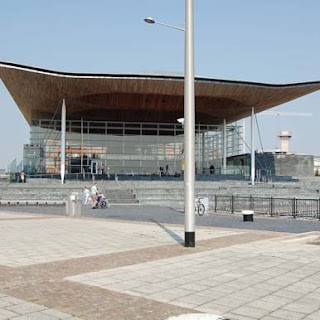 The Senedd building continues to prove its green credentials.
The Senedd building continues to prove its green credentials.
The home of the National Assembly for Wales has recently had its Display Energy Certificate rating upgraded from a ‘C’ to a ‘B’ making it one of the most energy efficient public buildings in the UK.
From its inception the Senedd was planned to be a sustainable and environmentally friendly structure.
Among its many features is a biomass boiler, geothermal heat pump and the use of natural heat and light to save energy.
Rain water is also harvested from the Senedd roof and is used for irrigation, maintenance and flushing WCs.
“This is excellent news for the National Assembly for Wales. It reinforces the belief that the Senedd was built to be open, accessible and sustainable for future generations in Wales. It is not only the seat of democracy in Wales but a leading light in environmentally-aware building design,” said Lorraine Barrett AM, Commissioner for the Sustainable Assembly.
Of the National Assembly for Wales’s other Cardiff Bay properties the Pierhead building has also recently been upgraded from a ‘C’ to a ‘B’ rating. The main administrative office of Ty Hywel has also been reclassified from a ‘G’ to an ‘F’ rating.
Ty Hywel was built in the late 1980s and has a mix of plant and equipment which was appropriate to the time. However a number of initiatives brought in by the Assembly’s environment and sustainability team has reduced the carbon footprint of around 800 occupants including Assembly staff, Assembly Members and their support staff.
“We recognise there is more work to be done to further reduce Ty Hywel’s carbon footprint but the measures already in place show we are moving in the right direction. We will continue to work with the Carbon Trust and engineering consultants Arup to make further efficiencies,” said the Cardiff South AM.
Some of the measures that help make the Senedd so green:
- Reprogrammed the building management system to reconfigure the operation and interaction of the plant and equipment so that for example heating and cooling are not operating simultaneously.
- Adjusted slightly the settings for heating in winter and cooling in winter by a few degrees, resulting in reduced energy usage.
- Implemented an overall energy efficiency control strategy that does not affect environmental conditions during occupancy but inhibits boilers and chillers operating unnecessarily at no or low load.
- As part of the scheduled plant replacement programme installing more energy efficient equipment, for example replacement chillers.
- Installed more energy efficient PIR (movement sensor controlled) lighting within the building as part of office refurbishments. This has resulted in lights not being left on in unoccupied areas and has resulted in an energy reduction.
- Installed energy sub meters to enhance our energy management data and information and identify areas for further improvements.